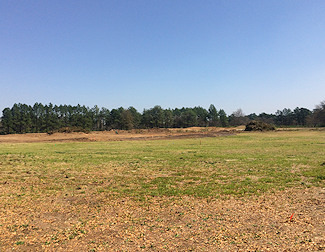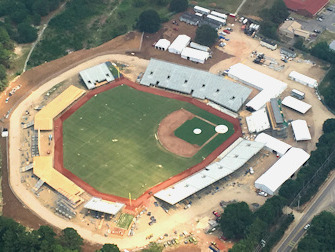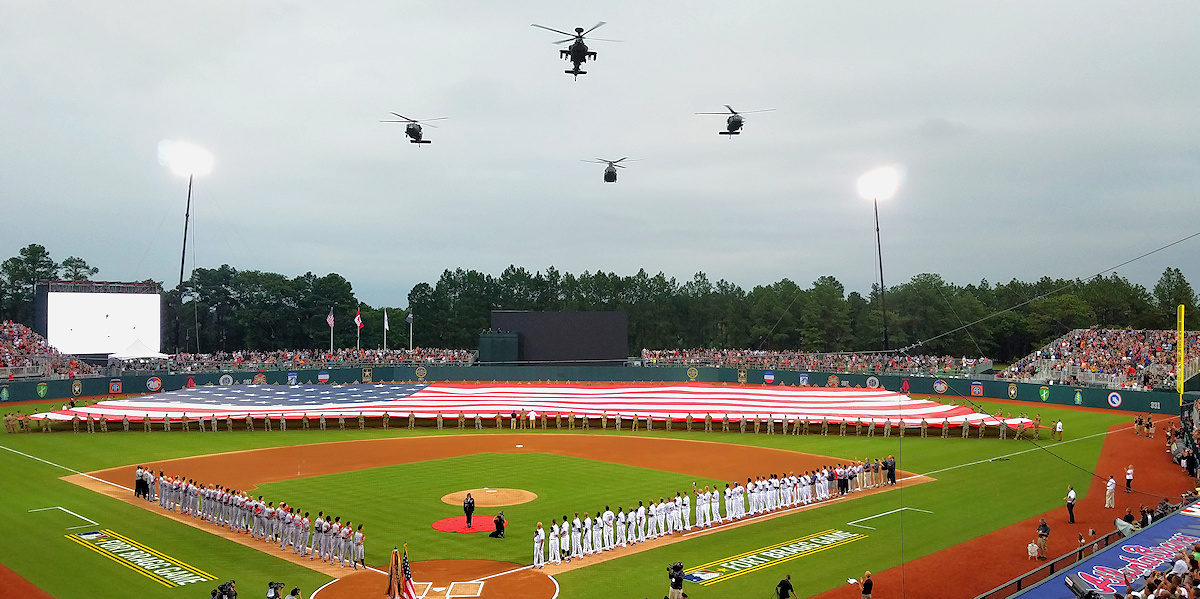Article and photos by Joe Mock, BaseballParks.com
All rights reserved
Don’t you hate overused adjectives, like “awesome” or “special”? And clichés that don’t even make sense, like “extremely unique”?
What if there was a ballpark that truly deserved such praise, one you could characterize as being “once in a lifetime”?
| Ballpark Stats |
 |
| Award: 2016 BaseballParks.com Ballpark of the Year. See press release here. |
| Used for: The Fort Bragg Game presented by Chevrolet |
| Only game: July 3, 2016, a 5-2 win for the Miami Marlins over the Atlanta Braves |
| Capacity: 12,500 |
| Dimensions: LF – 331; LCF – 387; CF – 405; RCF – 387; RF – 331 |
| Architect: Populous |
| Construction: coordinated by BaAM Productions |
| Price: estimated $5 million for the construction and materials |
| Home dugout: the Braves used the 1B dugout |
| Field points: northeast |
| Playing surface: Tifway 419 Bermudagrass |
| Betcha didn’t know: the clubhouses (which were huge tents) even had batting tunnels |
That, folks, is Fort Bragg Field. Another way you could put it is that it’s the best ballpark you’ll never see.
That’s because, for all intents and purposes, it only existed for one day. As you read this, it has already been dismantled. Put another way, no matter how intrigued you are with this park, you can’t visit it — even if you could find a way to enter the very secure military base. It’s simply no longer there.
That didn’t stop the no-longer-existing facility from being named our 2016 Ballpark of the Year! You can read the official press release explaining the award here.
But why was it built in the first place? And why was it torn down even more quickly than it was built? You’ve come to the right place to find the answers to these questions, although this won’t be one of our typical in-depth reviews of a ballpark. The fact that you can’t visit it now or in the future ensures that.
I was very fortunate to cover the one game played here. I wrote for USA TODAY about the event, so I was able to interview quite a few people about it and receive a guided tour by a representative from the park’s designers, Populous.
The Chief Operating Officer of Major League Baseball, Tony Pettiti, explained it this way to me. “Our Special Events, Marketing and Communications Departments had been kicking around ideas of bringing the game to places where they don’t traditionally see the game. Murray Cook who has handled (playing) fields for us in other places, gave us a list of suggestions, and on this list was Fort Bragg.
“All of us in the office came to the same conclusion, that Fort Bragg really stood out,” he added. “So we started asking ourselves if we could actually pull this thing off.”
As we’ll see, pulling it off turned out to be more challenging than even they knew at the time. But MLB started the ball rolling by contacting representatives at Fort Bragg and at the Department of Defense. “We received a reaction of ‘Wow, this is out of the blue, but really exciting.'”
So MLB headquarters asked the 30 team owners if they saw a problem with it, because it was going to cost a lot of money to accomplish this, especially since it would require building a ballpark to host the event. None of the owners objected. “When we (then) talked to the Players Association, they immediately saw the value in this and wanted to partner with us to make this happen,” Petitti revealed.
“So we looked at the schedule and we thought that a celebration of the military on July 4th weekend made a lot of sense.” Since the Braves and Marlins were already scheduled to play each other that weekend in Atlanta, MLB asked the two teams if they would go along with shifting their game on July 3rd to Fort Bragg. “They quickly said we’d love to do this,” Petitti said. “They embraced it immediately.”
With the internal approvals in place, MLB then began the process of gaining the green light from the military. Even though MLB and the Players Association were willing to foot the bill to make this happen, obtaining approval was a steep uphill climb.
Eric Hill is the Community Recreation Division Chief for the Directorate of Family and Morale at Fort Bragg. Consequently, the MLB game landed in his lap. He noted that the IMCOM Commanding General, the Atlantic Region Director, the Commanding General at Fort Bragg and the Garrison Commander all had to approve this. They did, but all that accomplished was paving the way for MLB to make a formal offer to provide this game as a “gift” to the military. That required another set of approvals, all the way up to the Acting Secretary of the Army. When he said yes, then the construction plans for the ballpark had to be reviewed by Congress.
| After all, it is a military base |
 |
| Before members of the media were taken on a shuttle to the site of the ballpark, a bomb-sniffing dog checked over everyone’s bags and cameras. |
“Next thing you knew, we were putting a shovel in the ground,” Petitti noted. The groundbreaking occurred on March 8th, less than four months from the date of the game. And if you know anything about ballparks, you know 16 weeks isn’t usually sufficient to build one, much less one with a Major League-caliber playing surface and clubhouses.
“Trust me, we have faced some ferocious deadlines associated with this (project),” said Todd Barnes, Principal at Populous, the firm that acted as both architects and event planners. “But this is the nature of this temporary-event world.”
And despite weather that didn’t always cooperate and the complexity of getting building materials onto a secure military base, the field and park were ready by June 27, exactly on schedule. That in and of itself is miraculous. But there’s another of those over-used adjectives … but in this instance, I believe it’s accurate.
As an aside, I was very pleased that MLB didn’t sell the “naming rights” to all kinds of parts of the ballpark. There was no Bank of America Bleachers or the Coca-Cola Berm. No, the only sponsorship was for the event itself, as MLB formally referred to it as The Fort Bragg Game Presented by Chevrolet. I can easily live with that. And considering we’re talking about the National Pastime and it was 4th of July weekend, that made a lot more sense than The Fort Bragg Game Presented by Mitsubishi or Hyundai.
So let’s take an in-depth look at Fort Bragg Field, the name pinned on this project by Major League Baseball.
The Setting
When MLB and the Players Association selected Fort Bragg to host the event, it made perfect sense. It’s the largest military base (by population) in the world, with over 54,000 active duty service personnel, which represents about 10% of the entire U.S. Army. Counting the soldiers’ families, military retirees, National Guard, reservists and civilian workers for the Defense Department, there are a staggering 250,000 people within Fort Bragg’s 500 square miles. So this was the logical spot for MLB to hold a game to show its appreciation for the military.
The installation is just north of Fayetteville, North Carolina, making it about 45 miles south of Raleigh-Durham.
As Lieutenant General Stephen Townsend, the Commanding General at Fort Bragg, told ESPN’s audience, he was very grateful when MLB made the offer to play the game at his base, but he had to inform them that there was no ballpark there to hold the game. “They said, ‘No problem, we’ll build one.'” MLB representatives worked with the local people, and they picked an interesting spot. “This was an overgrown, old golf course (that had) gone to seed,” Townsend said. “They turned it into this beautiful ballfield.”
  |
| The shot on the left (courtesy of Populous) shows the abandoned fairways of the golf course right before construction began. On the right (provided by Chief Warrant Officer 3 Joseph A. Baker of the U.S. Army), you see the layout of all of the ballpark’s elements as everything was nearing completion. |
The long-range plans for the playing field helped determine the site. “We immediately had in mind the location because we had an old golf course that we’ve had a master plan to convert to an outdoor sports complex,” Hill revealed. Since MLB intended to leave behind the playing field once the ballpark was disassembled, it would form the perfect centerpiece of the recreation area. Because of this, the Defense Department approved funding “to build three additional adult softball fields and nine multi-use youth fields to support our adult and youth programs” adjacent to the site, Hill said.
Imagine playing your slow-pitch softball game on turf fit for Major Leaguers — and one actually used by Major Leaguers.
The selected site “presented some positives,” said Barnes. “It was flat. We knew it would have good drainage and it had enough clear space to be able to accommodate a ballpark with 12,500 seats.” However, the golf course’s location is several miles from the Butner Road gates on Bragg Boulevard along the eastern edge of the base. Trucks carrying the materials for the park would have to traverse some streets that aren’t all that wide, and that was after they went through the process to gain entry to the secure base (as Commissioner Manfred pointed out in the pre-game press conference, MLB underestimated all of the security issues involved in staging a game on a military base). The narrow streets would also “present some issues in being able to get the military to and from the game,” Barnes observed.
In the end, the plan worked. The materials arrived in time to finish erecting the structures by June 27, and despite a downpour several hours before gametime on July 3rd, the servicemen and women arrived with no major traffic snarls. And needless to say, they were extremely enthusiastic and appreciative … plus they were very well-behaved.
The Exterior
Because Fort Bragg Field is anything but your typical ballpark, its exterior is nothing like you’ve seen. There was an outer perimeter fence, which was necessary because this was a ticketed event.
But Populous was able to position the park’s footprint so that a row of trees was just beyond most of the fencing. This made a pleasant effect when fans were walking around the outer concourse, which ringed the entire facility.
 |
There were three entry points for the facility. The one behind home plate was just for media and VIPs, such as MLB officials and their guests. The two where the service men and women entered were behind the foul poles. Those using the right field gates (shown above) were entering from Butner Road. Those entering in left field were coming from Reilly Road.
Time to check inside the confines of Fort Bragg Field (and look at a lot more photos), so read on!
